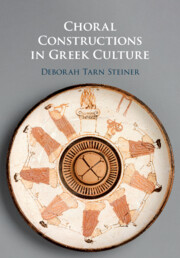Solo Dance in Archaic and Classical Greek Literature
Representing the Unruly Body
$41.99 ( ) USD
- Author: Sarah Olsen, Williams College, Massachusetts
- Date Published: December 2020
- availability: This ISBN is for an eBook version which is distributed on our behalf by a third party.
- format: Adobe eBook Reader
- isbn: 9781108620260
Find out more about Cambridge eBooks
$
41.99 USD
( )
Adobe eBook Reader
Other available formats:
Paperback, Hardback
Looking for an examination copy?
If you are interested in the title for your course we can consider offering an examination copy. To register your interest please contact [email protected] providing details of the course you are teaching.
-
“Ancient Greek dance” traditionally evokes images of stately choruses or lively Dionysiac revels – communal acts of performance. This is the first book to look beyond the chorus to the diverse and complex representation of solo dancers in Archaic and Classical Greek literature. It argues that dancing alone signifies transgression and vulnerability in the Greek cultural imagination, as isolation from the chorus marks the separation of the individual from a range of communal social structures. It also demonstrates that the solo dancer is a powerful figure for literary exploration and experimentation, highlighting the importance of the singular dancing body in the articulation of poetic, narrative, and generic interests across Greek literature. Taking a comparative approach and engaging with current work in dance and performance studies, this book reveals the profound literary and cultural importance of the unruly solo dancer in the ancient Greek world.
Read more- Offers the first investigation of solo dance in Archaic and Classical Greek literature and culture
- Interrogates the relationship between dance and literature across a range of genres
- Compares ancient Greek representations of dance to performances and theories drawn from other times and places
Customer reviews
Not yet reviewed
Be the first to review
Review was not posted due to profanity
×Product details
- Date Published: December 2020
- format: Adobe eBook Reader
- isbn: 9781108620260
- availability: This ISBN is for an eBook version which is distributed on our behalf by a third party.
Table of Contents
Introduction: Dance, Literature, and Culture
1. The Fantastic Phaeacians: Virtuosity, Competition, and Dance in the Odyssey
2. Io's Dance: Human Mobility and Divine Authority in Aeschylus' Prometheus Bound
3. Dance at Work: Performance and Identity in Euripides' Ion
4. Dance and Dissonance: The Innovative Choreography of Aristophanes' Wasps
5. Staging Madwomen: Dance and Dramatic Form in Euripides and Aristophanes
6. Agency, Narrative, and the Dancing Girl
7. Dance History
Conclusion: Reading Dance with Lucian.
Sorry, this resource is locked
Please register or sign in to request access. If you are having problems accessing these resources please email [email protected]
Register Sign in» Proceed
You are now leaving the Cambridge University Press website. Your eBook purchase and download will be completed by our partner www.ebooks.com. Please see the permission section of the www.ebooks.com catalogue page for details of the print & copy limits on our eBooks.
Continue ×Are you sure you want to delete your account?
This cannot be undone.
Thank you for your feedback which will help us improve our service.
If you requested a response, we will make sure to get back to you shortly.
×



